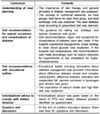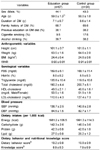1. Albarran NB, Ballesteros MN, Morales GG, Orteqa MI. Dietary behavior and type 2 diabetes care. Patient Educ Couns. 2006. 61:191–199.

2. Bruce DG, Davis WA, Cull CA, Davis TM. Diabetes education and knowledge in patients with type 2 diabetes from the community with type 2 diabetes from the community The Fremantle Diabetes Study. J Diabetes Complications. 2002. 17:82–89.

3. Christensen NK, Steiner J, Whalen J, Pfister R. Contribution of Medical Nutrition Therapy and Diabetes Self-management Education to Diabetes Control As Assessed by Hemoglobin A1C. Diabetes Spectrum. 2000. 13:72–75.
4. Delahanty LM, Halford BN. The role of diet behaviors in achieving improved glycemic control in intensively treated patients in the Diabetes Control and Complications Trial. Diabetes Care. 1993. 16:1453–1458.

5. Dunn SM, Beeney LJ, Hoskins PL, Turtle JR. Knowledge and attitude change as predictors of metabolic improvement in diabetes education. Soc Sci Med. 1990. 31:1135–1141.

6. Elshaw EB, Young EA, Saunders MJ, McGurn WC, Lopez LC. Utilizing a 24-hour dietary recall and culturally specific diabetes education in Mexican Americans with diabetes. Diabetes Educ. 1994. 20:228–235.

7. Fitzgerald JT, Funnell MM, Hess GE, Barr PA, Anderson RM, Hiss RG, Davis WK. The reliability and validity of a brief diabetes knowledge test. Diabetes Care. 1998. 21:706–710.

8. Franz MJ, Monk A, Barry B, McClain K, Weaver T, Cooper N, Upham P, Bergenstal R, Mazze Rs. Effectiveness of medical nutrition therapy provided by dietitians in the management of non-insulin-dependent diabetes mellitus: a randomized, controlled clinical trial. J Am Diet Assoc. 1995. 95:1009–1017.

9. Genuth S, Eastman R, Kahn R, Klein R, Lachin J, Lebobitz H, Nathan D, Vinicor F. American Diabetes Association. Implications of the United Kingdom prospective diabetes study (UKPDS). Diabetes Care. 2003. 26:S28–S32.
10. Gray RS, Fabsitz RR, Cowan LD, Lee ET, Howard BV, Savage PJ. Risk factor clustering in the insulin resistance syndrome: the Strong Heart Study. Am J Epidemiol. 1998. 148:869–878.

11. Hayes JT, Boucher JL, Pronk NP, Gehling E, Spencer M, Waslaski J. The role of the certified diabetes educator in telephone counseling. Diabetes Educ. 2001. 27:377–386.

12. Hopkins PN, Hunt SC, Wu LL, Williams GH, Williams RR. Hypertension, dyslipidemia, and insulin resistance: links in a chain or spokes on a wheel? Curr Opin Lipidol. 1996. 7:241–253.

13. Jiang YD, Chuang LM, Wu HP, Shaiau SJ, Wang CH, Lee YJ, Juang JH, Lin BJ, Tai TY. Assessment of the function and effect of diabetes education programs in Taiwan. Diabetes Res Clin Pract. 1999. 46:177–182.

14. Johnson EQ, Valera S. Medical nutrition therapy by registered dietitians improves HbA1c levels (Abstract) . Diabetes. 2001. 50:A21.
15. Kim HS, Oh JA. Adherence to diabetes control recommendations: impact of nurse telephone calls. Nurse Educ Pract. 2003. 44:256–261.

16. Kim YS, Seung JJ. A study on the Evaluation of Diet-Education Program of Diabetes. Journal of Korean Diabetes Association. 1985. 10:191–196.
17. Ko SH, Song KH, Kim SR, Lee JM, Kim JS, Shin JH, Cho YK, Park YM, Jeong JH, Yoon KH, Cha BY, Son HY, Ahn YB. Long-term effects of a structured intensive diabetes education program (SIDEP) in patients with type 2 diabetes mellitus-a 4 year follow-up study. Diabet Med. 2007. 24:55–62.

18. Lee KU, Choi YA, Lee YH, Park SW, Yoo HJ, Kim SY, Lee HK, Min HK. Development of a diabetes knowledge test. Journal of Korean Diabetes Association. 1985. 9:89–93.
19. Lee YA. The effect of nutrition education on diet quality and weight loss in middle-aged women. 2007. Seoul. Republic of Korea: Ewha Womans University Graduate School;Master's Thesis.
20. Lemon CC, Lacev K, Lohsw B, Hubacher DO, Klawitter B, Palta M. Outcomes monitoring of health, behavior, and quality of life after nutrition intervention in adults with type 2 diabetes. J Am Diet Assoc. 2004. 104:1805–1815.

21. Lim HS, Chyun JH, Kim YS, Nam MS. Effect of nutrition education on diabetic management in diabetic patients. The Korean Journal of Nutrition. 2001. 34:69–78.
22. Lindstorm J, Louheranta A, Manelin M, Rastas M, Salminen V, Erilsson J, Uusotupa M, Tuomilehto J. The Finnish Diabetes Prevention Study (DPS): Lifestyle intervention and 3 year results in diet and physical activity. Diabetes Care. 2003. 26:3230–3236.
23. Maljanian R, Grey N, Staff I, Conroy L. Intensive telephone follow-up to a hospital based disease management model for patients with diabetes mellitus. Dis Manag. 2005. 8:15–25.

24. Miller CK, Edwards L, Kissling G, Samville L. Nutrition education improves metabolic outcomes among older adults with diabetes mellitus: results from a randomized controlled trial. Prev Med. 2002. 34:252–259.

25. Norris SL, Engelgau MM, Narayan KM. Effectiveness of self-management training in type 2 diabetes: a systematic review of randomized controlled trials. Diabetes Care. 2001. 24:561–587.
26. Oh SY, Kim EM, Shin MH, Lee SH, Kim JE, Lee HS, Cho JS, Kim WY. Development and validity of food frequency questionnaire for adults. The Korean Society of Health Promotion. 2007. In : Annual Spring Conference; Seoul. Republic of Korea:
27. Park JS, Ahn CW. Educational program for diabetic patients in Korea-multidisplinary intensive management. Diabetes Res Clin Pract. 2007. 77:S194–S198.

28. Shabbidar S, Fathi B, Shirazifard M. Effects of clinical nutrition education on glycemic control outcomes in type 2 diabetes. International Journal of Diabetes in Developing Countries. 2006. 26:156–159.

29. Woo YJ, Lee HS, Kim WY. Individual Diabetes Nutrition Education Can Help Management for Type 2 Diabetes. The Korean Journal of Nutrition. 2005. 39:641–648.




 PDF
PDF ePub
ePub Citation
Citation Print
Print







 XML Download
XML Download